Monitoring the Integrity and Vulnerability of Linear Urban Infrastructure in a Reclaimed Coastal City Using SAR Interferometry
Abstract
1. Introduction
2. Study Area
3. Data and Methods
3.1. Data
3.2. Methods
3.2.1. Time Series Sentinel-1 SLC Data Processing Using the PSInSAR Technique
3.2.2. Proxy-Based Validation: Correlation Analysis
3.2.3. Hotspot Analysis and Hyperbolic Model-Based Nonlinear Ground Subsidence Prediction
4. Results
4.1. PSInSAR-Based Ground Displacement Monitoring in Mokpo City
4.2. Correlation of PSInSAR-Derived VLM with Hydrogeological, Geotechnical and Geomorphic Attributions
4.3. Vulnerability Mapping of Linear Infrastructure
4.4. The Temporal Evolution of Road and Railway Settlement Along Highly Vulnerable Corridors
4.5. Hyperbolic Model-Based Nonlinear Settlement Forecasting
5. Discussion
6. Conclusions
Supplementary Materials
Author Contributions
Funding
Data Availability Statement
Acknowledgments
Conflicts of Interest
References
- Li, M.G.; Chen, J.J.; Xu, Y.S.; Tong, D.G.; Cao, W.W.; Shi, Y.J. Effects of groundwater exploitation and recharge on land subsidence and infrastructure settlement patterns in Shanghai. Eng. Geol. 2021, 282, 105995. [Google Scholar] [CrossRef]
- Ramirez, R.A.; Kwon, T.H. Sentinel-1 persistent scatterer interferometric synthetic aperture radar (PS-InSAR) for long-term remote monitoring of ground subsidence: A case study of a port in Busan, South Korea. KSCE J. Civ. Eng. 2022, 26, 4317–4329. [Google Scholar] [CrossRef]
- Zanjani, F.A.; Amelung, F.; Piter, A.; Sobhan, K.; Tavakkoliestahbanati, A.; Eberli, G.P.; Haghighi, M.H.; Motagh, M.; Milillo, P.; Mirzaee, S.; et al. Insar observations of construction-induced coastal subsidence on Miami’s barrier islands, Florida. Earth Space Sci. 2024, 11, e2024EA003852. [Google Scholar] [CrossRef]
- Lee, H.; Kim, S.-J.; Kang, B.-H.; Lee, K.-S. Long-term settlement prediction of ground reinforcement foundation using a deep cement mixing method in reclaimed land. Buildings 2022, 12, 1279. [Google Scholar] [CrossRef]
- Zhang, B.; Liao, X.; Zhang, J.; Xiong, S.; Wang, C.; Wu, S.; Zhu, C.; Zhu, J.; Qin, X.; Li, Q. Megalopolitan-scale ground deformation along metro lines in the Guangdong-Hong Kong-Macao Greater Bay Area, China, revealed by MT-InSAR. Int. J. Appl. Earth Obs. Geoinf. 2023, 122, 103432. [Google Scholar] [CrossRef]
- Ohenhen, L.O.; Zhai, G.; Lucy, J.; Werth, S.; Carlson, G.; Khorrami, M.; Shirzaei, M. Land subsidence risk to infrastructure in US metropolises. Nat. Cities 2025, 2, 543–554. [Google Scholar] [CrossRef]
- Yang, X.; Wu, H.; Zhou, S.; Guo, D.; Chen, R. Land subsidence in coastal reclamation with impact on metro operation under rapid urbanization: A case study of Shenzhen. Sci. Total Environ. 2025, 970, 179020. [Google Scholar] [CrossRef] [PubMed]
- Wu, P.C.; Wei, M.; D’Hondt, S. Subsidence in coastal cities throughout the world observed by InSAR. Geophys. Res. Lett. 2022, 49, e2022GL098477. [Google Scholar] [CrossRef]
- Tay, C.; Lindsey, E.O.; Chin, S.T.; McCaughey, J.W.; Bekaert, D.; Nguyen, M.; Hill, E.M. Sea-level rise from land subsidence in major coastal cities. Nat. Sustain. 2022, 5, 1049–1057. [Google Scholar] [CrossRef]
- Shirzaei, M.; Freymueller, J.; Törnqvist, T.E.; Galloway, D.L.; Dura, T.; Minderhoud, P.S. Measuring, modelling and projecting coastal land subsidence. Nat. Rev. Earth Environ. 2021, 2, 40–58. [Google Scholar] [CrossRef]
- Herrera-García, G.; Ezquerro, P.; Tomás, R.; Béjar-Pizarro, M.; López-Vinielles, J.; Rossi, M.; Ye, S. Mapping the global threat of land subsidence. Science 2021, 371, 34–36. [Google Scholar] [CrossRef]
- Erkens, G.; Bucx, T.; Dam, R.; De Lange, G.; Lambert, J. Sinking coastal cities. Proc. Int. Assoc. Hydrol. Sci. 2015, 372, 189–198. [Google Scholar] [CrossRef]
- Chaussard, E.; Amelung, F.; Abidin, H.; Hong, S.H. Sinking cities in Indonesia: ALOS PALSAR detects rapid subsidence due to groundwater and gas extraction. Remote Sens. Environ. 2013, 128, 150–161. [Google Scholar] [CrossRef]
- Indraratna, B.; Rujikiatkamjorn, C.; Balasubramaniam, A.S. Consolidation of Estuarine Marine Clays for Coastal Reclamation Using Vacuum and Surcharge Loading. In From Soil Behavior Fundamentals to Innovations in Geotechnical Engineering: Honoring Roy E. Olson; ASCE: Reston, VA, USA, 2014; pp. 358–369. [Google Scholar] [CrossRef]
- Lam, Y.C.; Ganendra, D.; Prasad, K. Land reclamation & soil improvement works for a coal-fired power plant in Malaysia. Jpn. Geotech. Soc. Spec. Publ. 2016, 2, 1767–1772. [Google Scholar] [CrossRef]
- Leung, C.F.; Wong, J.C.; Manivanann, R.; Tan, S.A. Experimental evaluation of consolidation behavior of stiff clay lumps in reclamation fill. Geotech. Test. J. 2001, 24, 145–156. [Google Scholar] [CrossRef]
- Park, K.; Kim, Y.J.; Chen, J.; Nam, B.H. InSAR-based investigation of ground subsidence due to excavation: A case study of Incheon City, South Korea. Int. J. Geo-Eng. 2024, 15, 26. [Google Scholar] [CrossRef]
- Thilakarathne, T.; Vidurapriya, K.; Thilakasiri, H. Computational Approach for Determining the Variation of Coefficient of Secondary Compression in Secondary Settlement Prediction of Soft Soils. In Proceedings of the SLIIT International Conference on Engineering and Technology, Malabe, Sri Lanka, 25 March 2023; Available online: https://rda.sliit.lk/handle/123456789/3580 (accessed on 28 September 2025).
- Mesri, G.; Godlewski, P.M. Time-and stress-compressibility interrelationship. J. Geotech. Eng. Div. 1977, 103, 417–430. [Google Scholar] [CrossRef]
- Madhav, M.; Ramu, K. Modeling and analysis of reclamation process. Int. J. Geotech. Eng. 2009, 3, 535–551. [Google Scholar] [CrossRef]
- Bo, M.W.; Choa, V.; Hong, K.H. Material characterization of Singapore Marine Clayat Changi. Q. J. Eng. Geol. Hydrogeol. 2003, 36, 305–319. [Google Scholar] [CrossRef]
- Karademir, T.; Dışkaya, B. Composite Sand–Clay Infrastructural Soil Fills: Characteristic Consolidation and Hydraulic Properties. J. Adv. Res. Nat. Appl. Sci. 2024, 10, 640–658. [Google Scholar] [CrossRef]
- Mitchell, J.K.; Soga, K. Fundamentals of Soil Behavior, 3rd ed.; John Wiley & Sons: Hoboken, NJ, USA, 2005. [Google Scholar]
- Shi, C.; Wang, Y. Assessment of reclamation-induced consolidation settlement considering stratigraphic uncertainty and spatial variability of soil properties. Can. Geotech. J. 2022, 59, 1215–1230. [Google Scholar] [CrossRef]
- Park, S.W.; Hong, S.H. Nonlinear modeling of subsidence from a decade of InSAR time series. Geophys. Res. Lett. 2021, 48, e2020GL090970. [Google Scholar] [CrossRef]
- Kim, S.W.; Wdowinski, S.; Dixon, T.H.; Amelung, F.; Won, J.S.; Kim, J.W. InSAR-based mapping of surface subsidence in Mokpo City, Korea, using JERS-1 and ENVISAT SAR data. Earth Planets Space 2008, 60, 453–461. [Google Scholar] [CrossRef]
- Nur, A.S.; Achmad, A.R.; Lee, C.W. Land subsidence measurement in reclaimed coastal land: Noksan using C-band sentinel-1 radar interferometry. J. Coast. Res. 2020, 102, 218–223. [Google Scholar] [CrossRef]
- Kim, J.S.; Kim, D.J.; Kim, S.W.; Won, J.S.; Moon, W.M. Monitoring of urban land surface subsidence using PSInSAR. Geosci. J. 2007, 11, 59–73. [Google Scholar] [CrossRef]
- Hong, S.H. Monitoring Time-Series Subsidence Observation in Incheon Using X-Band COSMO-SkyMed Synthetic Aperture Radar. Korean J. Remote Sens. 2024, 40, 141–150. [Google Scholar] [CrossRef]
- Sengupta, D.; Chen, R.; Meadows, M.E.; Banerjee, A. Gaining or losing ground? Tracking Asia’s hunger for ‘new’coastal land in the era of sea level rise. Sci. Total Environ. 2020, 732, 139290. [Google Scholar] [CrossRef]
- Kim, S.W.; Kim, C.O.; Won, J.S.; Kim, J.W. Measurement of Ground Subsidence in Mokpo Area from Radar Intrerferometry. Econ. Environ. Geol. 2005, 38, 381–394. Available online: https://www.kseeg.org/journal/view.html?uid=459 (accessed on 28 September 2025).
- Adhikari, M.D.; Park, S.; Yum, S.G. Coastal vulnerability to extreme weather events: An integrated analysis of erosion, sediment movement, and land subsidence based on multi-temporal optical and SAR satellite data. J. Environ. Manag. 2025, 374, 124025. [Google Scholar] [CrossRef]
- Lee, K.; Nam, J.; Park, J.; Hong, G. Numerical Analysis of Factors Influencing the Ground Surface Settlement above a Cavity. Materials 2022, 15, 8301. [Google Scholar] [CrossRef]
- Oh, D.W.; Kong, S.M.; Lee, D.Y.; Yoo, Y.S.; Lee, Y.J. Effects of Reinforced Pseudo-Plastic Backfill on the Behavior of Ground around Cavity Developed due to Sewer Leakage. J. Korean Geoenvironmental Soc. 2015, 16, 13–22. [Google Scholar] [CrossRef]
- Jeon, S.S.; Park, Y.K.; Eum, K.Y. Stability assessment of roadbed affected by ground subsidence adjacent to urban railways. Nat. Hazards Earth Syst. Sci. 2018, 18, 2261–2271. [Google Scholar] [CrossRef]
- Chen, H.; Liang, D. Roadbed Subsidence Mechanisms under the Driven of Penetration-Soak Coupling. J. Geosci. Environ. Prot. 2017, 5, 97–106. [Google Scholar] [CrossRef]
- Zhang, Y.; Jiao, Y.Y.; He, L.L.; Tan, F.; Zhu, H.M.; Wei, H.L.; Zhang, Q.B. Susceptibility mapping and risk assessment of urban sinkholes based on grey system theory. Tunn. Undergr. Space Technol. 2024, 152, 105893. [Google Scholar] [CrossRef]
- Zhao, D.; Yao, H.; Gu, X. Highway deformation monitoring by multiple InSAR technology. Sensors 2024, 24, 2988. [Google Scholar] [CrossRef] [PubMed]
- Lomibao, A.L.; Leal, G.A.; Mabaquiao, L.C.; Reyes, R.B. Ground deformation monitoring of reclaimed lands along manila bay freeport zone using PS-InSAR technique. Int. Arch. Photogramm. Remote Sens. Spat. Inf. Sci. 2024, 48, 335–342. [Google Scholar] [CrossRef]
- Bai, M.; Qi, Y.; Song, L.; Wang, Q.; Zhang, Z.; Tian, G. Research on real-time monitoring and early warning of Tangshan road surface subsidence based on InSAR. Adv. Space Res. 2025, 75, 4408–4430. [Google Scholar] [CrossRef]
- Orellana, F.; Delgado Blasco, J.M.; Foumelis, M.; D’aranno, P.J.; Marsella, M.A.; Di Mascio, P. Dinsar for road infrastructure monitoring: Case study highway network of Rome metropolitan (Italy). Remote Sens. 2020, 12, 3697. [Google Scholar] [CrossRef]
- Zhang, J.; Ke, C.; Shen, X.; Lin, J.; Wang, R. Monitoring land subsidence along the subways in Shanghai on the basis of time-series InSAR. Remote Sens. 2023, 15, 908. [Google Scholar] [CrossRef]
- Lyu, M.; Ke, Y.; Li, X.; Zhu, L.; Guo, L.; Gong, H. Detection of seasonal deformation of highway overpasses using the PS-InSAR technique: A case study in Beijing urban area. Remote Sens. 2020, 12, 3071. [Google Scholar] [CrossRef]
- Shi, X.; Niu, F.; Qu, T.; Zhang, H.; Jiang, M.; Jiang, H.; Wang, X. Stability analysis of Shiwei-Labudalin highway in inner mongolia, Northeastern China using sentinel-1 InSAR. Cold Reg. Sci. Technol. 2022, 202, 103647. [Google Scholar] [CrossRef]
- Liu, H.; Huang, S.; Xie, C.; Tian, B.; Chen, M.; Chang, Z. Monitoring Roadbed stability in permafrost area of Qinghai–Tibet railway by MT-InSAR technology. Land 2023, 12, 474. [Google Scholar] [CrossRef]
- Wang, R.; Yang, T.; Yang, M.; Liao, M.; Lin, J. A safety analysis of elevated highways in Shanghai linked to dynamic load using long-term time-series of InSAR stacks. Remote Sens. Lett. 2019, 10, 1133–1142. [Google Scholar] [CrossRef]
- Dai, K.; Liu, G.; Li, Z.; Ma, D.; Wang, X.; Zhang, B.; Li, G. Monitoring highway stability in permafrost regions with X-band temporary scatterers stacking InSAR. Sensors 2018, 18, 1876. [Google Scholar] [CrossRef] [PubMed]
- Azadnejad, S.; Hrysiewicz, A.; Trafford, A.; O’Loughlin, F.; Holohan, E.; Kelly, F.; Donohue, S. InSAR supported by geophysical and geotechnical information constrains two-dimensional motion of a railway embankment constructed on peat. Eng. Geol. 2024, 333, 107493. [Google Scholar] [CrossRef]
- Fadhillah, M.F.; Achmad, A.R.; Lee, C.W. Integration of InSAR time-series data and GIS to assess land subsidence along subway lines in the Seoul metropolitan area, South Korea. Remote Sens. 2020, 12, 3505. [Google Scholar] [CrossRef]
- Guo, F.; Lyu, M.; Li, X.; Jiang, J.; Wang, L.; Guo, L.; Wang, F. Deformation Monitoring Along Beijing Metro Line 22 Using PS-InSAR Technology. Land 2025, 14, 1098. [Google Scholar] [CrossRef]
- Tao, R.; Lau, A.; Mossefin, M.E.; Kong, G.; Nordal, S.; Pan, Y. Monitoring of ground displacement-induced railway anomalies using PS-InSAR techniques. Measurement 2025, 248, 116863. [Google Scholar] [CrossRef]
- Wang, R.; Yang, M.; Dong, J.; Liao, M. Investigating deformation along metro lines in coastal cities considering different structures with InSAR and SBM analyses. Int. J. Appl. Earth Obs. Geoinf. 2022, 115, 103099. [Google Scholar] [CrossRef]
- Xu, X.; Zhao, D.; Ma, C.; Lian, D. Monitoring subsidence deformation of Suzhou subway using InSAR timeseries analysis. IEEE Access 2020, 9, 3400–3416. [Google Scholar] [CrossRef]
- Ramirez, R.A.; Lee, G.J.; Choi, S.K.; Kwon, T.H.; Kim, Y.C.; Ryu, H.H.; Kim, S.; Bae, B.; Hyun, C. Monitoring of construction-induced urban ground deformations using Sentinel-1 PS-InSAR: The case study of tunneling in Dangjin, Korea. Int. J. Appl. Earth Obs. Geoinf. 2022, 108, 102721. [Google Scholar] [CrossRef]
- Perissin, D.; Wang, Z.; Lin, H. Shanghai subway tunnels and highways monitoring through Cosmo-SkyMed Persistent Scatterers. ISPRS J. Photogramm. Remote Sens. 2012, 73, 58–67. [Google Scholar] [CrossRef]
- Karunathilake, A.; Ohashi, M.; Kaneta, S.; Chiba, T. Tunnel-induced land subsidence assessment in a densely populated residential area using Sentinel-1 PS-InSAR. Discov. Geosci. 2024, 2, 81. [Google Scholar] [CrossRef]
- Giardina, G.; Milillo, P.; DeJong, M.J.; Perissin, D.; Milillo, G. Evaluation of InSAR monitoring data for post-tunnelling settlement damage assessment. Struct. Control Health Monit. 2019, 26, e2285. [Google Scholar] [CrossRef]
- Bianchini Ciampoli, L.; Gagliardi, V.; Ferrante, C.; Calvi, A.; D’Amico, F.; Tosti, F. Displacement monitoring in airport runways by persistent scatterers SAR interferometry. Remote Sens. 2020, 12, 3564. [Google Scholar] [CrossRef]
- Shi, X.; Zhong, J.; Yin, Y.; Chen, Y.; Zhou, H.; Wang, M.; Dai, K. Integrating SBAS-InSAR and LSTM for subsidence monitoring and prediction at Hong Kong international airport. Ore Energy Resour. Geol. 2023, 15, 100032. [Google Scholar] [CrossRef]
- Wu, S.; Yang, Z.; Ding, X.; Zhang, B.; Zhang, L.; Lu, Z. Two decades of settlement of Hong Kong International Airport measured with multi-temporal InSAR. Remote Sens. Environ. 2020, 248, 111976. [Google Scholar] [CrossRef]
- Zhang, R.; Zhang, W.; Huang, W.; Ma, T.; Wang, Q.; Fang, K.; Wang, K. High-precision monitoring method for airport deformation based on time-series InSAR technology. Constr. Build. Mater. 2023, 366, 130144. [Google Scholar] [CrossRef]
- Xiong, S.-H.; Wang, Z.-P.; Li, G.; Skibniewski, M.J.; Chen, Z.-S. Prediction of airport runway settlement using an integrated SBAS-InSAR and BP-EnKF approach. Inf. Sci. 2024, 665, 120376. [Google Scholar] [CrossRef]
- Kim, W.; Hwang, S.; Han, H.; Park, B.; Yoo, W. Identification of Risk Zones During Infrastructure Construction and Maintenance Using Satellite SAR Data for Sustainable Urban Areas in South Korea. Sustainability 2024, 16, 10627. [Google Scholar] [CrossRef]
- Soeung, S.; Lee, S.-H.; Lee, S.J.; Kim, B.-J.; Yune, C.-Y. Causing factors of additional settlement in high-speed railways in Korea. KSCE J. Civ. Eng. 2018, 22, 3843–3851. [Google Scholar] [CrossRef]
- Park, H. Study for Application of Artificial Neural Networks in Geotechnical Problems. In Artificial Neural Networks—Application; IntechOpen: London, UK, 2011; pp. 303–336. [Google Scholar] [CrossRef]
- Lee, H.; Oh, J. Establishing an ANN-based risk model for ground subsidence along railways. Appl. Sci. 2018, 8, 1936. [Google Scholar] [CrossRef]
- Choi, E.K.; Kim, S.W.; Cho, J.W.; Lee, J.H. GIS-based subsidence hazard map in urban area. J. Korean Geotech. Soc. 2017, 33, 5–14. [Google Scholar] [CrossRef]
- Adhikari, M.D.; Kim, S.W.; Kim, H.J.; Tuganishuri, J.; Yum, S.G.; Kim, J. Monitoring Roadbed Stability to Prevent Cascading Hazards in Daejeon City, South Korea, Using Sentinel-1 SAR Data. In Proceedings of the International Conference on Construction Engineering and Project Management (ICCEPM 2024), Sapporo, Japan, 29 July–1 August 2024; Korea Institute of Construction Engineering and Management: Seoul, Republic of Korea, 2024; pp. 102–111. [Google Scholar] [CrossRef]
- Kim, B.K.; Lee, C.; Kim, W.; Yoo, M.; Lee, I. A Study on the D-InSAR Method for Micro-deformation Monitoring in Railway Facilities. J. Korean Geotech. Soc. 2022, 38, 43–54. [Google Scholar] [CrossRef]
- Kim, S.W.; Wdowinski, S.; Dixon, T.H.; Amelung, F.; Kim, J.W.; Won, J.S. Measurements and predictions of subsidence induced by soil consolidation using persistent scatterer InSAR and a hyperbolic model. Geophys. Res. Lett. 2010, 37, 1–5. [Google Scholar] [CrossRef]
- Kim, S.Y.; Bae, T.S.; Kim, S.W. Time Series Analysis with ALOS PALSAR images and GPS data: Detection of Ground Subsidence in the Mokpo Area using the SBAS Algorithm. J. Korean Soc. Surv. Geod. Photogramm. Cartogr. 2013, 31, 375–384. [Google Scholar] [CrossRef]
- Lee, Y. Coastal planning strategies for adaptation to sea level rise: A case study of Mokpo, Korea. J. Build. Constr. Plan. Res. 2014, 2, 74–81. [Google Scholar] [CrossRef]
- Yum, S.G.; Song, M.S.; Adhikari, M.D. Assessing Typhoon Soulik-induced morphodynamics over the Mokpo coastal region in South Korea based on a geospatial approach. Nat. Hazards Earth Syst. Sci. 2023, 23, 2449–2474. [Google Scholar] [CrossRef]
- Kim, B.; Hong, T.K. A national Vs30 model for South Korea to combine nationwide dense borehole measurements with ambient seismic noise analysis. Earth Space Sci. 2022, 9, e2021EA002066. [Google Scholar] [CrossRef]
- He, H.; Zhou, L.; Lee, H. Ground displacement variation around power line corridors on the loess plateau estimated by persistent scatterer interferometry. IEEE Access 2021, 9, 87908–87917. [Google Scholar] [CrossRef]
- Kirui, P.; Oiro, S.; Waithaka, H.; Odera, P.; Riedel, B.; Gerke, M. Detection, characterization, and analysis of land subsidence in Nairobi using InSAR. Nat. Hazards 2022, 113, 213–236. [Google Scholar] [CrossRef]
- Qin, Y.; Perissin, D.; Bai, J. Investigations on the coregistration of Sentinel-1 TOPS with the conventional cross-correlation technique. Remote Sens. 2018, 10, 1405. [Google Scholar] [CrossRef]
- Hanssen, R.F. Radar Interferometry: Data Interpretation and Error Analysis; Springer Science & Business Media: Dordrecht, The Netherlands, 2001; Volume 2. [Google Scholar]
- Ferretti, A.; Prati, C.; Rocca, F. Permanent scatterers in SAR interferometry. IEEE Trans. Geosci. Remote Sens. 2001, 39, 8–20. [Google Scholar] [CrossRef]
- Perissin, D.; Wang, Z.; Wang, T. The SARPROZ InSAR Tool for Urban Subsidence/Manmade Structure Stability Monitoring in China. In Proceedings of the International Symposium on Remote Sensing of Environment (ISRSE), Sydney, Australia, 10–15 April 2011; Available online: https://www.isprs.org/PROCEEDINGS/2011/ISRSE-34/211104015Final00632.pdf (accessed on 28 September 2025).
- Foroughnia, F.; Nemati, S.; Maghsoudi, Y.; Perissin, D. An iterative PS-InSAR method for the analysis of large spatio-temporal baseline data stacks for land subsidence estimation. Int. J. Appl. Earth Obs. Geoinf. 2019, 74, 248–258. [Google Scholar] [CrossRef]
- Xu, H.; Chen, F.; Zhou, W. A comparative case study of MTInSAR approaches for deformation monitoring of the cultural landscape of the Shanhaiguan section of the Great Wall. Herit. Sci. 2021, 9, 71. [Google Scholar] [CrossRef]
- Yang, F.; Zhi, M.; An, Y. Revealing large-scale surface subsidence in Jincheng City’s mining clusters using MT-InSAR and VMD-SSA-LSTM time series prediction model. Sci. Rep. 2025, 15, 5726. [Google Scholar] [CrossRef]
- Hussain, S.; Pan, B.; Afzal, Z.; Ali, M.; Zhang, X.; Shi, X.; Ali, M. Landslide detection and inventory updating using the time-series InSAR approach along the Karakoram Highway, Northern Pakistan. Sci. Rep. 2023, 13, 7485. [Google Scholar] [CrossRef]
- Ramzan, U.; Fan, H.; Aeman, H.; Ali, M.; AAAl-qaness, M. Combined analysis of PS-InSAR and hypsometry integral (HI) for comparing seismic vulnerability and assessment of various regions of Pakistan. Sci. Rep. 2022, 12, 22423. [Google Scholar] [CrossRef]
- Khorrami, M.; Abrishami, S.; Maghsoudi, Y.; Alizadeh, B.; Perissin, D. Extreme subsidence in a populated city (Mashhad) detected by PSInSAR considering groundwater withdrawal and geotechnical properties. Sci. Rep. 2020, 10, 11357. [Google Scholar] [CrossRef]
- Hussain, M.A.; Chen, Z.; Shoaib, M.; Shah, S.U.; Khan, J.; Ying, Z. Sentinel-1A for monitoring land subsidence of coastal city of Pakistan using Persistent Scatterers In-SAR technique. Sci. Rep. 2022, 12, 5294. [Google Scholar] [CrossRef]
- Fárová, K.; Jelének, J.; Kopačková-Strnadová, V.; Kycl, P. Comparing DInSAR and PSI techniques employed to Sentinel-1 data to monitor highway stability: A case study of a massive Dobkovičky landslide, Czech Republic. Remote Sens. 2019, 11, 2670. [Google Scholar] [CrossRef]
- Nicholls, R.J.; Lincke, D.; Hinkel, J.; Brown, S.; Vafeidis, A.T.; Meyssignac, B.; Fang, J. A global analysis of subsidence, relative sea-level change and coastal flood exposure. Nat. Clim. Change 2021, 11, 338–342. [Google Scholar] [CrossRef]
- Wang, K.; Chen, J.; Valseth, E.; Wells, G.; Bettadpur, S.; Jones, C.E.; Dawson, C. Subtle land subsidence elevates future storm surge risks along the gulf coast of the United States. J. Geophys. Res. Earth Surf. 2024, 129, e2024JF007858. [Google Scholar] [CrossRef]
- Festa, D.; Novellino, A.; Hussain, E.; Bateson, L.; Casagli, N.; Confuorto, P.; Raspini, F. Unsupervised detection of InSAR time series patterns based on PCA and K-means clustering. Int. J. Appl. Earth Obs. Geoinf. 2023, 118, 103276. [Google Scholar] [CrossRef]
- Khalili, M.A.; Voosoghi, B.; Guerriero, L.; Haji-Aghajany, S.; Calcaterra, D.; Di Martire, D. Mapping of mean deformation rates based on APS-corrected InSAR data using unsupervised clustering algorithms. Remote Sens. 2023, 15, 529. [Google Scholar] [CrossRef]
- Rygus, M.; Novellino, A.; Hussain, E.; Syafiudin, F.; Andreas, H.; Meisina, C. A clustering approach for the analysis of InSAR Time Series: Application to the Bandung Basin (Indonesia). Remote Sens. 2023, 15, 3776. [Google Scholar] [CrossRef]
- Tan, T.S.; Inoue, T.; Lee, S.L. Hyperbolic method for consolidation analysis. J. Geotech. Eng. 1991, 117, 1723–1737. [Google Scholar] [CrossRef]
- Yastika, P.E.; Shimizu, N.; Abidin, H.Z. Monitoring of long-term land subsidence from 2003 to 2017 in coastal area of Semarang, Indonesia by SBAS DInSAR analyses using Envisat-ASAR, ALOS-PALSAR, and Sentinel-1A SAR data. Adv. Space Res. 2019, 63, 1719–1736. [Google Scholar] [CrossRef]
- Shi, G.; Lin, H.; Bürgmann, R.; Ma, P.; Wang, J.; Liu, Y. Early soil consolidation from magnetic extensometers and full resolution SAR interferometry over highly decorrelated reclaimed lands. Remote Sens. Environ. 2019, 231, 111231. [Google Scholar] [CrossRef]
- Choo, Y.S.; Kim, J.H.; Hwang, S.H.; Chung, C.K. The optimization of hyperbolic settlement prediction method with the field data for preloading on the soft ground. J. Korean Geotech. Soc. 2010, 26, 147–159. Available online: https://cdn.apub.kr/journalsite/archives/kgs/2010-26/07.pdf (accessed on 28 September 2025).
- Kim, S.; Lee, C.; Song, K.; Min, K.D.; Won, J. Application of L-band differential SAR interferometry to subsidence rate estimation in reclaimed coastal land. Int. J. Remote Sens. 2005, 26, 1363–1381. [Google Scholar] [CrossRef]
- Córdoba Hernández, R.; Camerin, F. The application of ecosystem assessments in land use planning: A case study for supporting decisions toward ecosystem protection. Futures 2024, 161, 103399. [Google Scholar] [CrossRef]
- Ferro-Azcona, H.; Espinoza-Tenorio, A.; Calderón-Contreras, R.; Ramenzoni, V.C.; País, M.d.L.M.G.; Mesa-Jurado, M.A. Adaptive capacity and social-ecological resilience of coastal areas: A systematic review. Ocean Coast. Manag. 2019, 173, 36–51. [Google Scholar] [CrossRef]
- Anderson, C.C.; Renaud, F.G.; Hanscomb, S.; Gonzalez-Ollauri, A. Green, hybrid, or grey disaster risk reduction measures: What shapes public preferences for nature-based solutions? J. Environ. Manag. 2022, 310, 114727. [Google Scholar] [CrossRef] [PubMed]
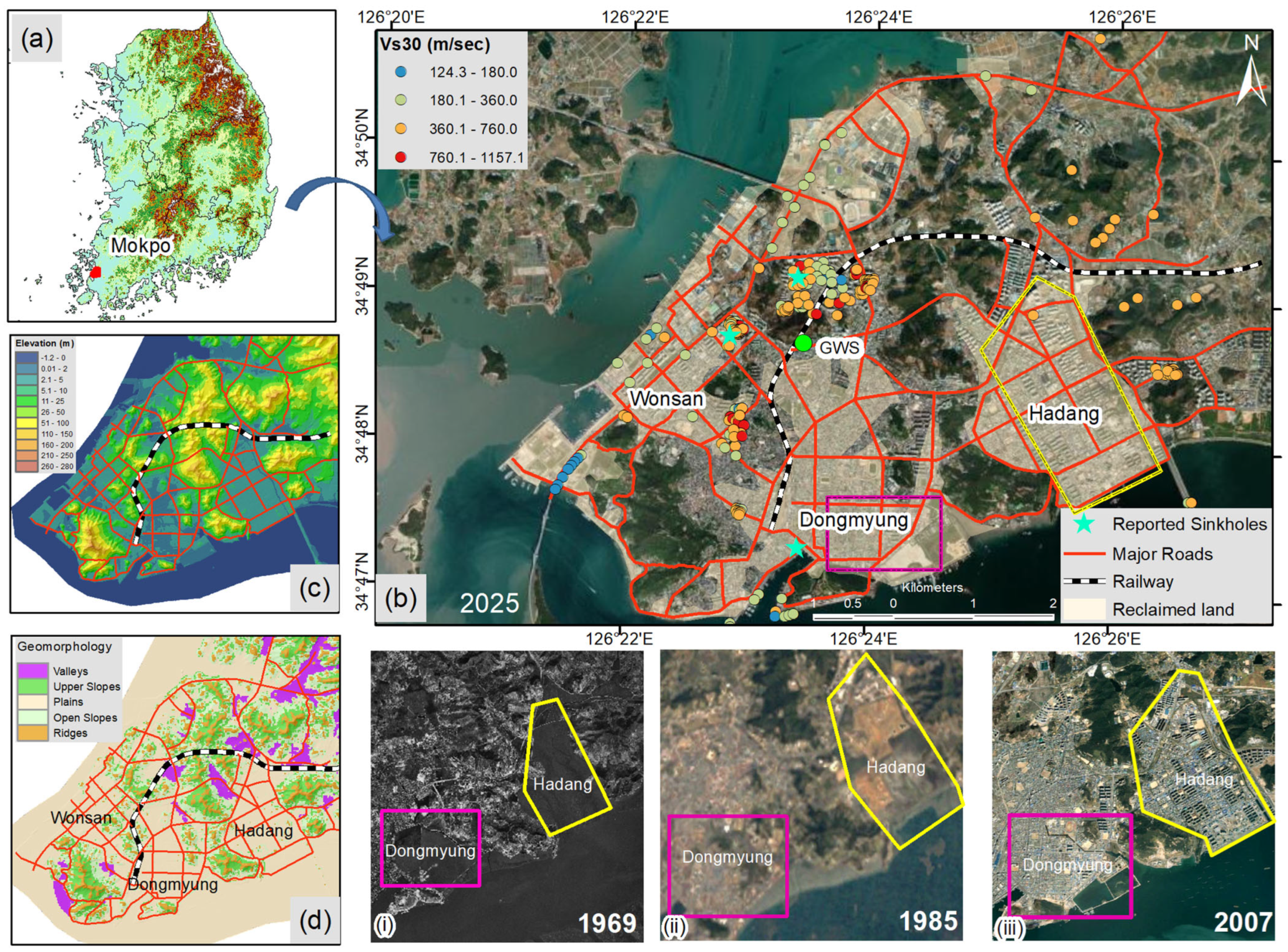
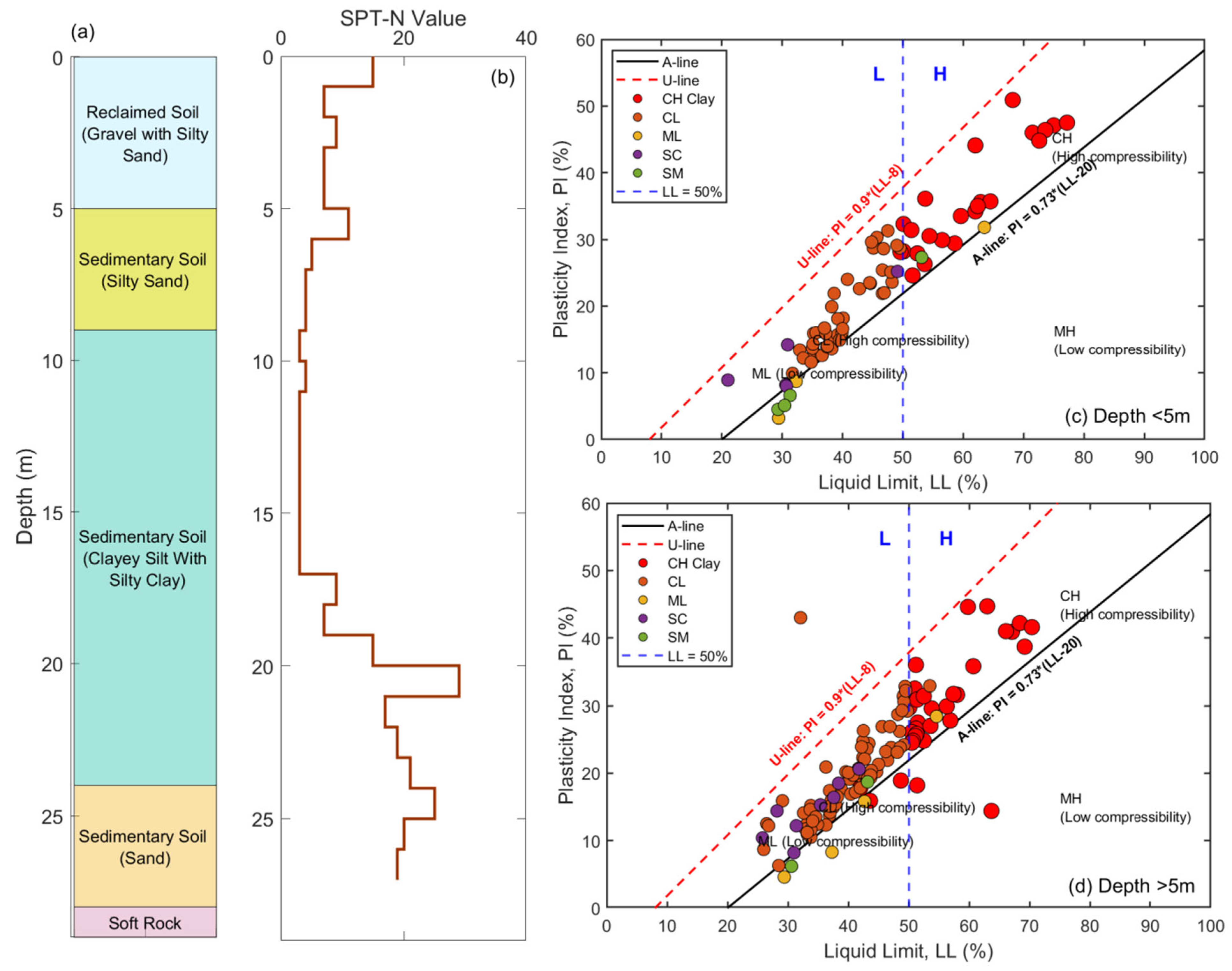
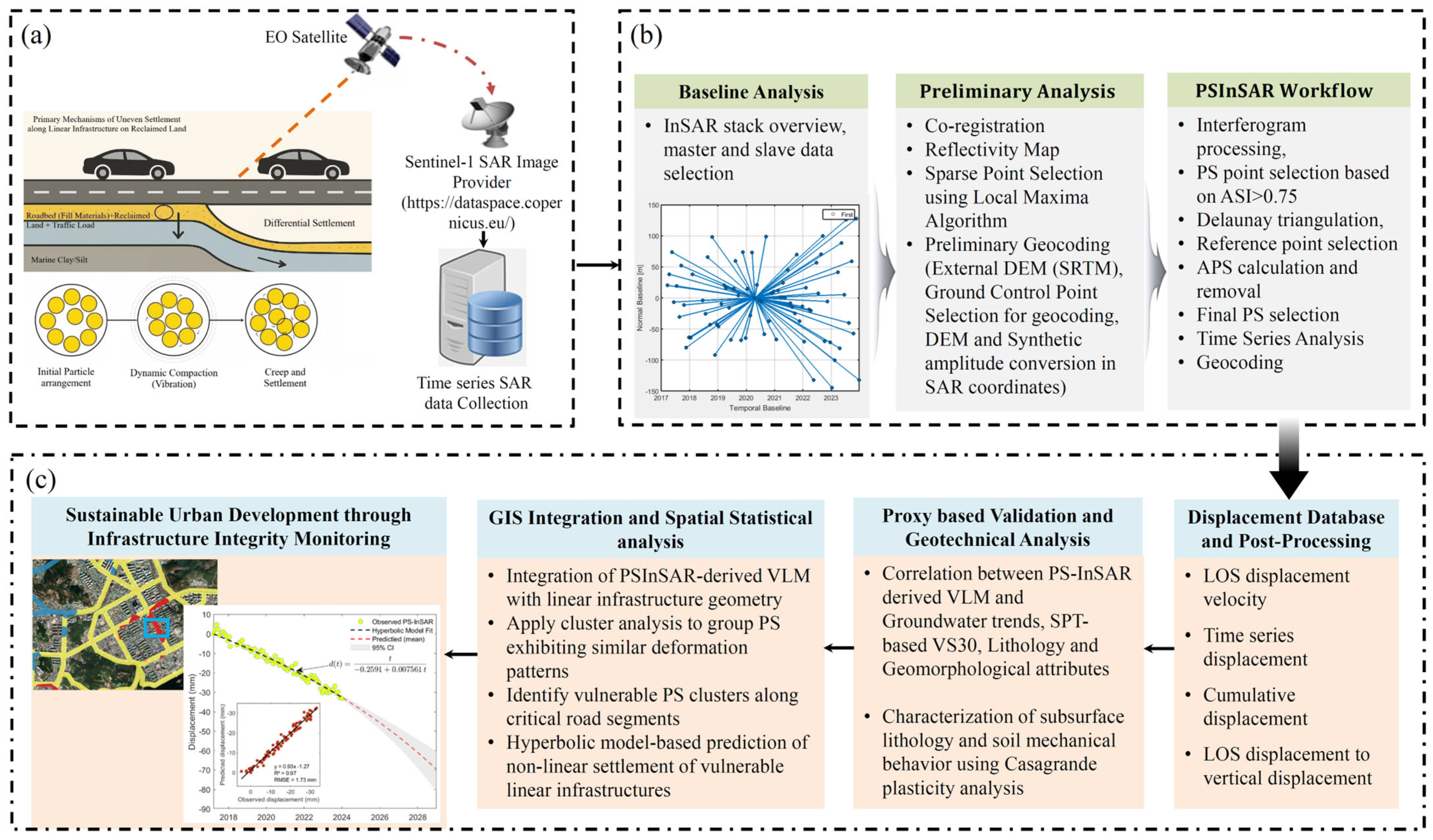
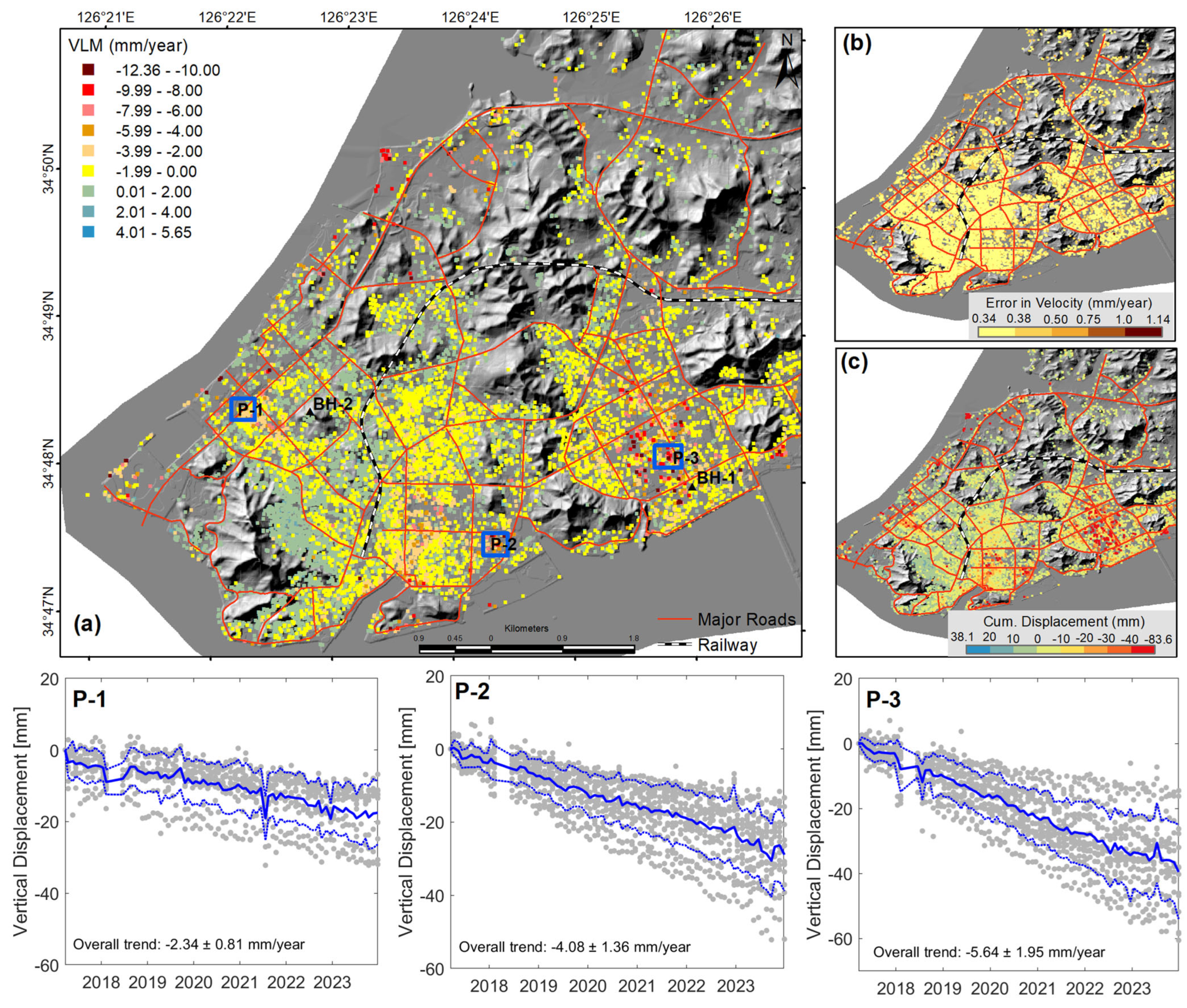

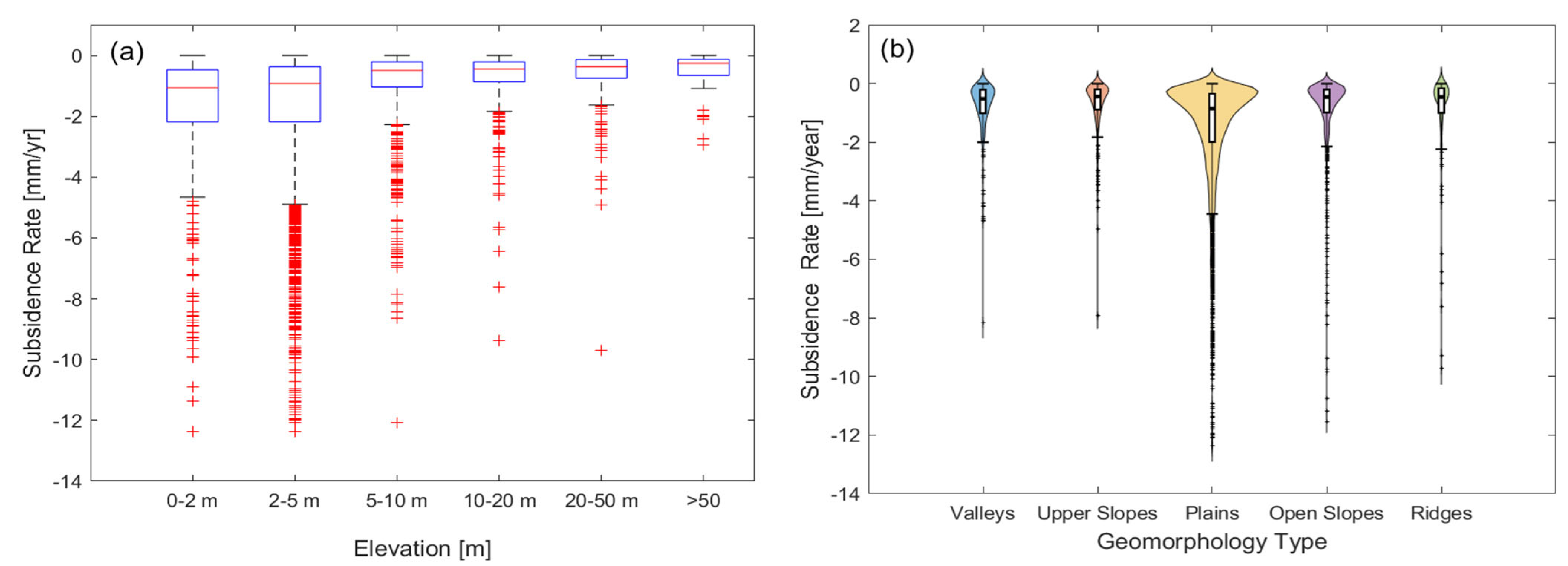

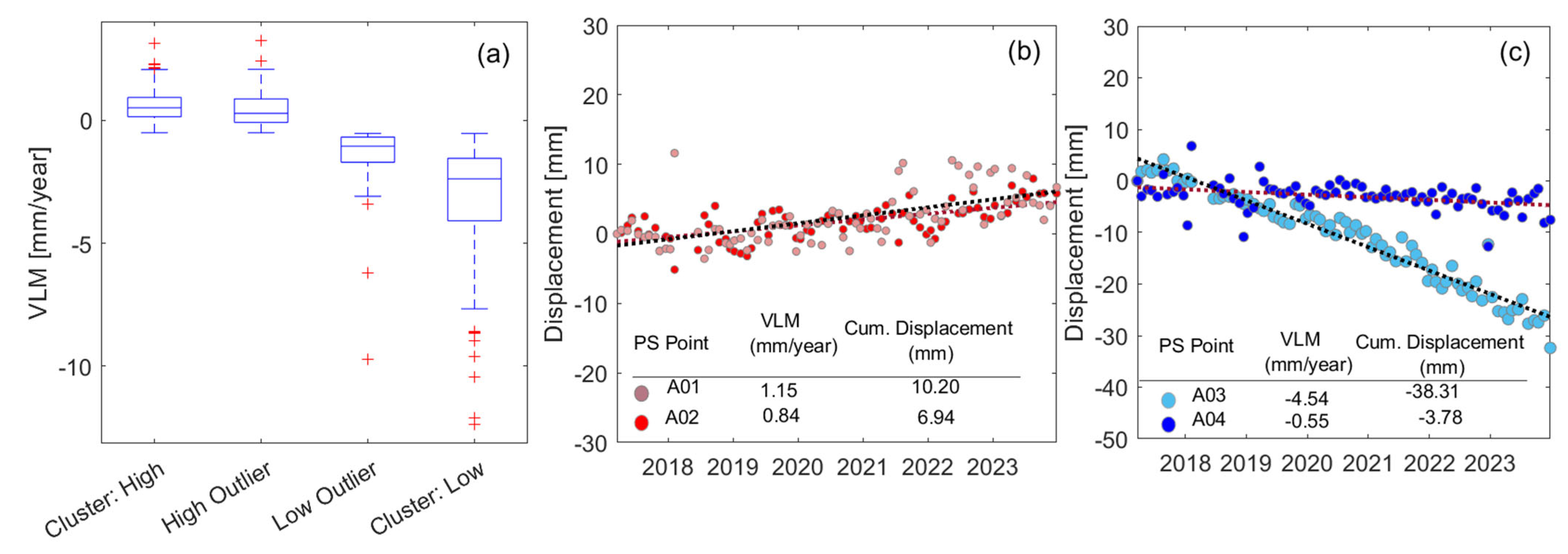
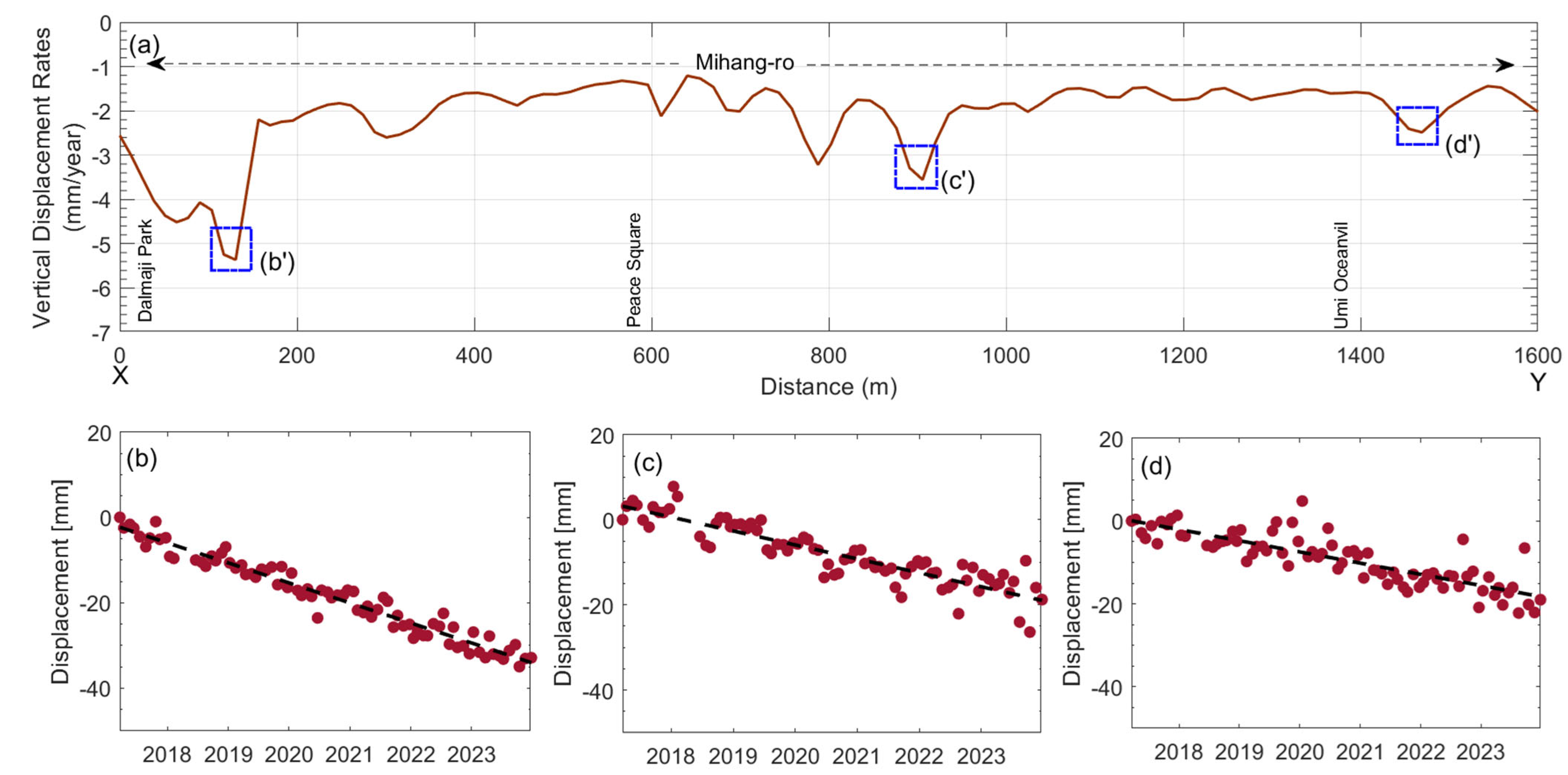

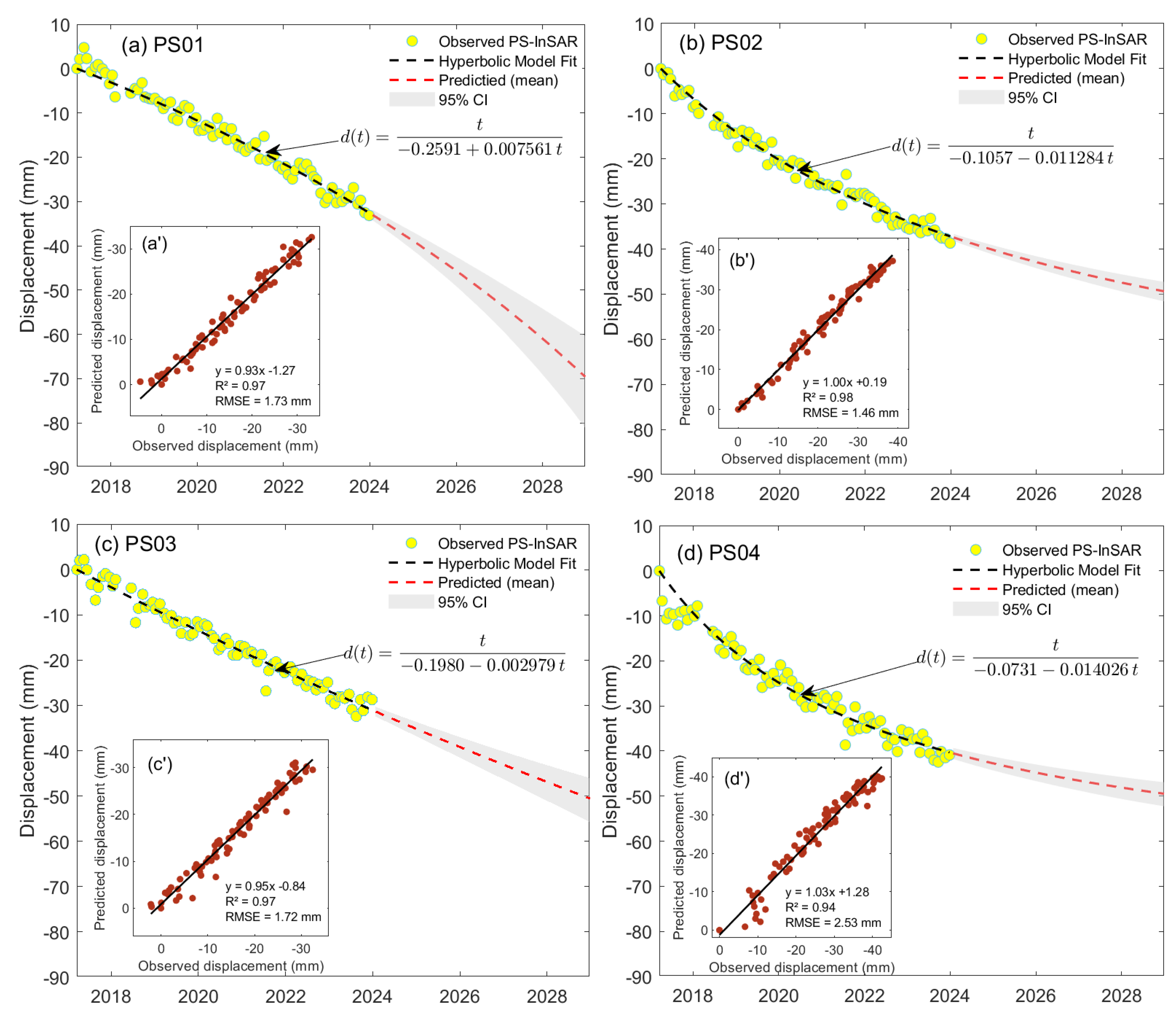
| Linear Infrastructures | SAR Data | Methods | References |
|---|---|---|---|
| Highway/Road | Time-series Sentinel-1 SLC, TerraSAR-X | DInSAR, SBAS, PSInSAR, DSInSAR, TSS-InSAR | [38,40,41,43,44,45,46,47] |
| Railway (intercity/high speed)/Metro Line | Time-series Sentinel-1 SLC, TerraSAR-X, ENVISAT ASAR, Radarsat-2 | PSInSAR, SBAS | [48,49,50,51,52] |
| Tunnel/Subway (urban underground corridors) | Time-series Sentinel-1 SLC, TerraSAR-X, ENVISAT ASAR, Cosmo-SkyMed | PSInSAR, SBAS | [42,53,54,55,56,57] |
| Airport | Envisat ASAR, Sentinel-1A, COSMO-SkyMed | PSInSAR, SBAS | [58,59,60,61,62] |
| Date | Location | Approx. Scale | Reported Cause | Sources |
|---|---|---|---|---|
| 1 March 1997 | Sanjeong-dong | Four-story residential complex tilted ~5 | Ground subsidence in mid-1980s landfill and poor foundation construction | https://imnews.imbc.com/replay/1997/nwdesk/article/1764218_30717.html, accessed on 28 September 2025 |
| 2 April 2014 | Sanjeong-dong | Road collapse 80 m long × 7 m wide | Poor safety management at nearby construction sites, sewer relocation | https://www.anjunj.com/news/articleView.html?idxno=10127, accessed on 28 September 2025 |
| 26 April 2016 | Shinheung-dong | Sinkhole ~2 m wide × 4 m deep on the road | Corrosion and breakage of aging sewer pipes | https://www.seoul.co.kr/news/society/2016/04/27/20160427500128, accessed on 28 September 2025 |
| 25 March 2018 | Yeonsan-dong | Surface opening 1.2 m wide × 1.5 m deep | JIS Underground Safety Information System (https://www.jis.go.kr/) https://sciencesay.shinyapps.io/sinkhole/, accessed on 28 September 2025 | |
| 16 June 2021 | Wonsan-dong | Sinkhole 1–2 m wide × 1.5 m deep | Defective soil refill | |
| 13 April 2022 | Dongmyeong-dong | Surface opening 1.5 m wide × 0.8 m deep (15 m lateral expansion) | Soil runoff from underground excavation for new construction | |
| 6 August 2025 | Yeonsan-dong | Sinkhole ~1 m wide × 4 m deep | Damage and leakage of >20-year-old sewers | https://www.mpmbc.co.kr/NewsArticle/1476923, accessed on 28 September 2025 |
| 22 September 2025 | Sanjeong-dong | Sinkhole ~0.5 m diameter × 0.7 m deep | Soil loss due to the failure of old sewer pipes | https://www.mpmbc.co.kr/NewsArticle/1484071, accessed on 28 September 2025 |
| Data | Source | Remarks |
|---|---|---|
| Sentinel-1SLC ascending orbit data | https://dataspace.copernicus.eu/, accessed on 21 September 2023 | Time Series Data, March 2017–December 2023; number of images = 79; Incident angle~33.80°, Heading Angle~ −169.295° |
| Linear Infrastructures Geometry | https://www.openstreetmap.org/, accessed on 25 July 2025 | Major Road and Railway Network |
| Digital Elevation Model (DEM) | National Geographic Information Institute (NGII) (ttps://www.ngii.go.kr/, accessed on 21 July 2023); SRTM (https://srtm.csi.cgiar.org/srtmdata/, accessed on 21 September 2023) | 5 × 5 m LiDAR DEM; 90 m SRTM DEM |
| Groundwater records | https://www.gims.go.kr, accessed on 21 July 2025 | Groundwater fluctuations (2017–2023) |
| Subsurface soil/rock properties | Kim and Hong [74] | Effective shear wave velocity (Vs30) (n = 326) |
| Geotechnical laboratory test data | Korea National Land and Geotechnical Information Portal (https://www.geoinfo.or.kr/, accessed on 21 July 2025) | Liquid Limit (LL), Plasticity Index (PI) (n = 120) |
| High-resolution Imageries | National Geographic Information Institute (NGII); Google Earth | Highlighted land reclamation and urbanization from 1969 to 2025 |
Disclaimer/Publisher’s Note: The statements, opinions and data contained in all publications are solely those of the individual author(s) and contributor(s) and not of MDPI and/or the editor(s). MDPI and/or the editor(s) disclaim responsibility for any injury to people or property resulting from any ideas, methods, instructions or products referred to in the content. |
© 2025 by the authors. Licensee MDPI, Basel, Switzerland. This article is an open access article distributed under the terms and conditions of the Creative Commons Attribution (CC BY) license (https://creativecommons.org/licenses/by/4.0/).
Share and Cite
Jeong, W.; Song, M.-S.; Adhikari, M.D.; Yum, S.-G. Monitoring the Integrity and Vulnerability of Linear Urban Infrastructure in a Reclaimed Coastal City Using SAR Interferometry. Buildings 2025, 15, 3865. https://doi.org/10.3390/buildings15213865
Jeong W, Song M-S, Adhikari MD, Yum S-G. Monitoring the Integrity and Vulnerability of Linear Urban Infrastructure in a Reclaimed Coastal City Using SAR Interferometry. Buildings. 2025; 15(21):3865. https://doi.org/10.3390/buildings15213865
Chicago/Turabian StyleJeong, WoonSeong, Moon-Soo Song, Manik Das Adhikari, and Sang-Guk Yum. 2025. "Monitoring the Integrity and Vulnerability of Linear Urban Infrastructure in a Reclaimed Coastal City Using SAR Interferometry" Buildings 15, no. 21: 3865. https://doi.org/10.3390/buildings15213865
APA StyleJeong, W., Song, M.-S., Adhikari, M. D., & Yum, S.-G. (2025). Monitoring the Integrity and Vulnerability of Linear Urban Infrastructure in a Reclaimed Coastal City Using SAR Interferometry. Buildings, 15(21), 3865. https://doi.org/10.3390/buildings15213865








